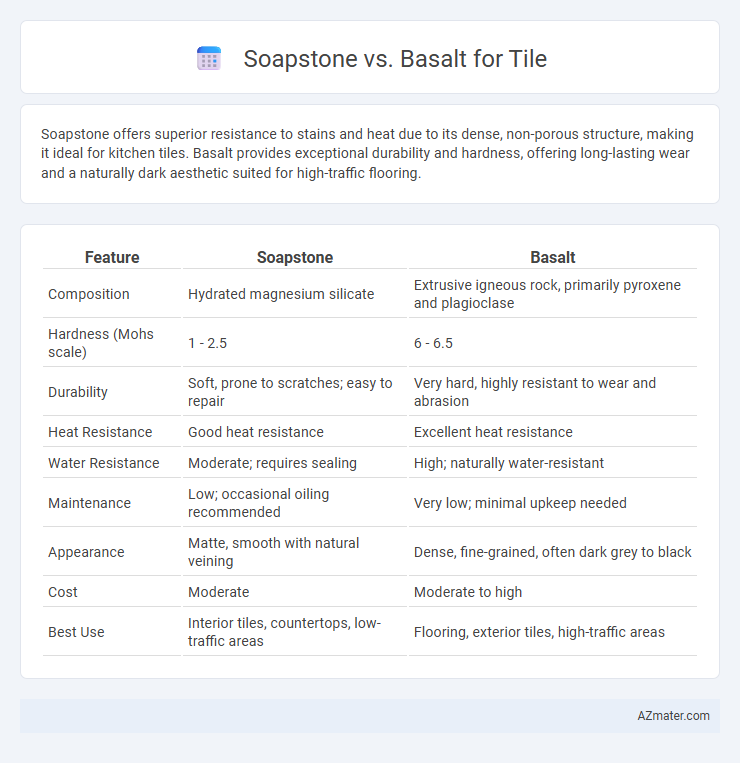Soapstone offers superior resistance to stains and heat due to its dense, non-porous structure, making it ideal for kitchen tiles. Basalt provides exceptional durability and hardness, offering long-lasting wear and a naturally dark aesthetic suited for high-traffic flooring.
Table of Comparison
| Feature | Soapstone | Basalt |
|---|---|---|
| Composition | Hydrated magnesium silicate | Extrusive igneous rock, primarily pyroxene and plagioclase |
| Hardness (Mohs scale) | 1 - 2.5 | 6 - 6.5 |
| Durability | Soft, prone to scratches; easy to repair | Very hard, highly resistant to wear and abrasion |
| Heat Resistance | Good heat resistance | Excellent heat resistance |
| Water Resistance | Moderate; requires sealing | High; naturally water-resistant |
| Maintenance | Low; occasional oiling recommended | Very low; minimal upkeep needed |
| Appearance | Matte, smooth with natural veining | Dense, fine-grained, often dark grey to black |
| Cost | Moderate | Moderate to high |
| Best Use | Interior tiles, countertops, low-traffic areas | Flooring, exterior tiles, high-traffic areas |
Introduction to Soapstone and Basalt Tiles
Soapstone tiles, composed primarily of talc and magnesium silicate, offer a smooth texture and excellent heat resistance, making them ideal for kitchen surfaces and bathrooms. Basalt tiles, derived from volcanic rock, are known for their hardness, durability, and natural dark gray color, providing a modern and sleek aesthetic for flooring and wall applications. Both materials resist moisture and stains, but soapstone's softer composition allows for easier shaping, while basalt's dense structure offers superior strength and longevity.
Geological Origins and Formation
Soapstone originates from talc-rich metamorphic rocks formed through the alteration of ultramafic rocks under low-grade metamorphism, resulting in a soft, heat-resistant material primarily composed of talc and chlorite. Basalt is an extrusive igneous rock formed from the rapid cooling of magnesium- and iron-rich lava at the Earth's surface, characterized by its fine-grained texture and high durability. These distinct geological formations influence their physical properties, with soapstone offering ease of carving and heat retention, while basalt provides exceptional hardness and weather resistance for tile applications.
Appearance and Color Variations
Soapstone offers a smooth, matte finish with subtle veining in shades of gray, green, and blue, creating a soft, natural look ideal for rustic or traditional tile designs. Basalt features a dense, fine-grained texture with deep black, dark gray, or sometimes greenish hues, providing a sleek, modern appearance with minimal color variation for a uniform tile surface. Both materials provide unique aesthetic options, with soapstone's organic patterns contrasting basalt's consistent, bold coloration in tile applications.
Durability and Strength Comparison
Soapstone offers moderate durability with good resistance to scratches and stains, making it suitable for low-traffic tile applications. Basalt, an igneous volcanic rock, provides superior strength and exceptional durability, making it highly resistant to wear, impact, and heavy foot traffic. For tile installations requiring long-lasting performance and minimal maintenance, basalt generally outperforms soapstone in both strength and durability metrics.
Maintenance and Care Requirements
Soapstone tiles require minimal maintenance, needing only occasional cleaning with mild soap and water, and benefit from periodic application of mineral oil to enhance their natural patina and prevent surface dryness. Basalt tiles are highly durable and low-maintenance, resisting stains and scratches, and typically only require routine cleaning with neutral pH cleaners and water to preserve their appearance. Both materials are naturally resilient, but soapstone's softer composition demands more attentive care to avoid dents and scratches compared to the harder, more abrasion-resistant basalt.
Slip Resistance and Safety
Soapstone offers a naturally smooth surface with moderate slip resistance, making it safer in dry conditions but potentially slippery when wet. Basalt features a rougher, textured surface that significantly increases grip, providing superior slip resistance and enhanced safety in both dry and wet environments. Choosing basalt tiles is advisable for areas prone to moisture, while soapstone suits low-moisture interiors where slip risk is minimal.
Heat and Stain Resistance
Soapstone offers exceptional heat resistance, making it ideal for use near hot surfaces like kitchen countertops and fireplace surrounds, while basalt also exhibits strong heat tolerance but with a higher density that enhances durability. Both materials provide good stain resistance, though soapstone naturally repels liquids due to its non-porous structure, requiring less sealing compared to basalt, which may need periodic sealing to maintain its stain-resistant properties. Their thermal stability and stain endurance make these stones prime choices for high-performance tile applications.
Environmental Impact and Sustainability
Soapstone offers a lower environmental impact compared to basalt due to its softer composition, requiring less energy-intensive quarrying and processing methods. Basalt, a dense volcanic rock, demands higher energy consumption during extraction and sawing, contributing to increased carbon emissions. Both materials are durable and long-lasting, but soapstone's renewable sourcing and minimal chemical treatment enhance its sustainability profile in tile applications.
Cost and Affordability
Soapstone tiles typically cost between $10 to $30 per square foot, making them moderately priced compared to other natural stones, while basalt tiles range from $8 to $25 per square foot, often offering a more budget-friendly option. The affordability of basalt arises from its abundant volcanic origin and ease of extraction, whereas soapstone's cost reflects its unique heat resistance and aesthetic appeal. Homeowners seeking cost-effective and durable flooring might prefer basalt for its lower price and hardiness, whereas those prioritizing luxury finishes may opt for soapstone despite higher expenses.
Best Applications: Soapstone vs Basalt Tile
Soapstone tiles excel in kitchens and bathrooms due to their natural resistance to heat, stains, and bacteria, making them ideal for countertops and flooring in moisture-prone areas. Basalt tiles offer superior durability and hardness, making them perfect for high-traffic commercial spaces, outdoor patios, and wall cladding where weather resistance and longevity are critical. Both materials provide unique aesthetic appeals, with soapstone showing a smooth matte finish and basalt featuring a dense, fine-grained texture for modern, sleek tile designs.

Infographic: Soapstone vs Basalt for Tile
 azmater.com
azmater.com